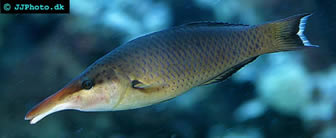Bird Wrasse
Gomphosus varius
Common name: Bird Wrasse, Greenbird Wrasse, Brownbird Wrasse, Blackbird Wrasse
Scientific name: Paraluteres prionurus
Max size: Males 14 in (11 in) / 35 cm (27.5 cm more common). Females 6 in / 15 cm.
pH: 8.1-8.4
Salinity: 1.020-1.025
Temperature: 72-78ºF (22-26°C)
Bird wrasse, Greenbird wrasse, Blackbird wrasse, Brownbird wrasse – many names but the same species. The different names do however have different meanings, so it can be good to clear this out once and for all. Bird wrasse is the name of the species. The name Greenbird wrasse refers to a male of the species Bird wrasse. The names Brownbird and Blackbird wrasse refer to females. You can read a little more about this further down in the breeding section of this article.
The Bird wrasse has a long narrow body with a long snout. The snout is not long in juveniles. The fish uses its snout is used to reach food in hard to reach places. Males are green. The green can be anything from olive to deep blue green. The females have this color on their posterior. The anterior is white whit brown spots. The snout on the females is orange.
The Bird wrasse can not be said to be a sensitive and hard to keep species, but it isn't really a difficult species to care for either. It’s a good choice for aquarists that have kept marine fish for a while and feel comfortable caring for moderately sensitive fish. It is not suitable for beginners.
The Bird wrasse can be kept as a singular fish or in pairs. If you want to keep a pair you should introduce the female before the male. The Bird wrasse is-semi aggressive towards other species and can be kept with most other suitably sized semi-aggressive fish species. Do not keep them with very aggressive fish such as triggers.
Bird wrasses are not reef safe as they will eat all shrimps, hermit crabs and other invertebrates they can find. Usually leaves corals and anemones alone.
The bird wrasse originates from the Indo-Pacific. It can be found in almost the entire tropical Indian Ocean and Pacific Ocean; frrom the east coast of Africa via Australia and Hawaii to islands off the coast of Florida, United States. Its distribution goes as far south as Australia and as far north as Japan. It is most common in the island rich area between Japan and Australia. It is found in areas with prolific coral growth at a depth of 0 -100 ft / 0-30 m.
Bird Wrasse care and aquarium setup:
If you want to keep Bird wrasse I recommend an aquarium no smaller than 100 gallon / 400 L. Some sources will tell you that a 70 gallon / 250 L tank is enough, but I think that is a bit on the small side. This doesn't mean that you can't keep them in a 70 gallon / 250 L tank, but your really shouldn't go any smaller than that.
The aquarium should be decorated with a lot of (live or regular) rocks that are arranged to create a lot of caves and other hiding places. The bottom should be covered with an at least 2 in /5 cm thick layer of sand so that the Bird wrasse can dig itself down if it gets spooked. It is important to leave open areas in the aquarium as this fish is always on the move and swimming around.
This species is suitable for "fish only" and "fish only with live rock" aquariums. It should not be kept in a reef aquarium as it as earlier mentioned isn't reef safe. They prefer a well circulated and well lit aquarium.The aquarium needs to be well covered to prevent them from jumping to their deaths.
Ideal conditions for Bird wrasse is pH 8.1-8.4, salinity 1.020-1.025, and temperature 72-78ºF (22-26°C).
Feeding Bird Wrasse
The Bird wrasse has developed into its peculiar body and snout shape due to its eating technique. They use their long snout to snag invertebrates and other small animals from among the tentacles of corals where other fish can't reach. They are easy to feed in aquarium and usually accept all types of food including flake food. Give them a varied diet including vegetable or algae based food and a lot of meaty food such as chopped up shrimp, mussels and clams. Feed your bird wrasse 2-4 times a day.
Breeding Bird Wrasse
Sexing bird wrasses is simple; they are actually so different that they commonly are sold under different names. The males are sold as Greenbird wrasse due to their green black coloration; females on the other hand are sold as Blackbird or Brownbird wrasse and only the back half of the females has the color seen in males, the rest of the body is silver white. Males are also larger than females; they can grow to be twice the length of the female. Bird wrasses are hermaphrodites and females can turn into males when the need for a male arises. This means that you only need to buy two juvenile fish to get pair as the dominant one will develop into a male. We have no information about breeding the Bird wrasse in aquariums.
Wrasse Articles:
Dragon Wrasse - Novaculichthys taeniourus
Harliquin Tuskfish – Coerodon fasciatus
Hogfish - Information about Hogfish
Neon Wrasse – Halichoeres melanurus
Ornate Wrasse – Halichoeres ornatissimus
Queen Coris – Coris frerei
Radient Wrasse – Halichoeres iridis
Spanish Hogfish – Bodianus rufus
Striated Wrasse – Pseudocheilinus evanidus
Yellow Coris – Halichoeres chrysus
Line Wrasses:
Fourline Wrasse – Pseudocheilinus tetrataenia
Sixline Wrasse – Pseudocheilinus hexataenia
Eightline Wrasse – Pseudocheilinus octotaenia
Fairy Wrasses:
Exquisite Fairy Wrasse – Cirrhilabrus exquisitus
Lubbock's Fairy Wrasse – Cirrhilabrus lubbocki
Scott's Fairy Wrasse – Cirrhilabrus scottorum
Solar Fairy Wrasse – Cirrhilabrus solorensis
Flasher Wrasses:
Carpenter's Flasher Wrasse – Paracheilinus carpenteri
Dot-and-Dash Flasher Wrasse – Paracheilinus lineopunctatus
Filamented Flasher Wrasse – Paracheilinus filamentosus
McCosker's Flasher Wrasse – Paracheilinus mccoskeri

